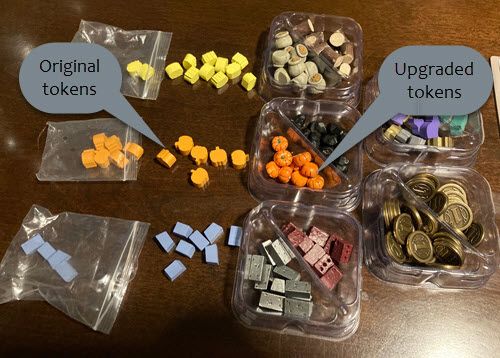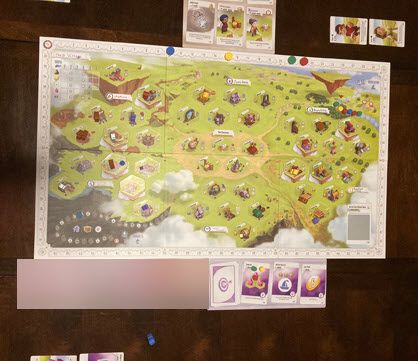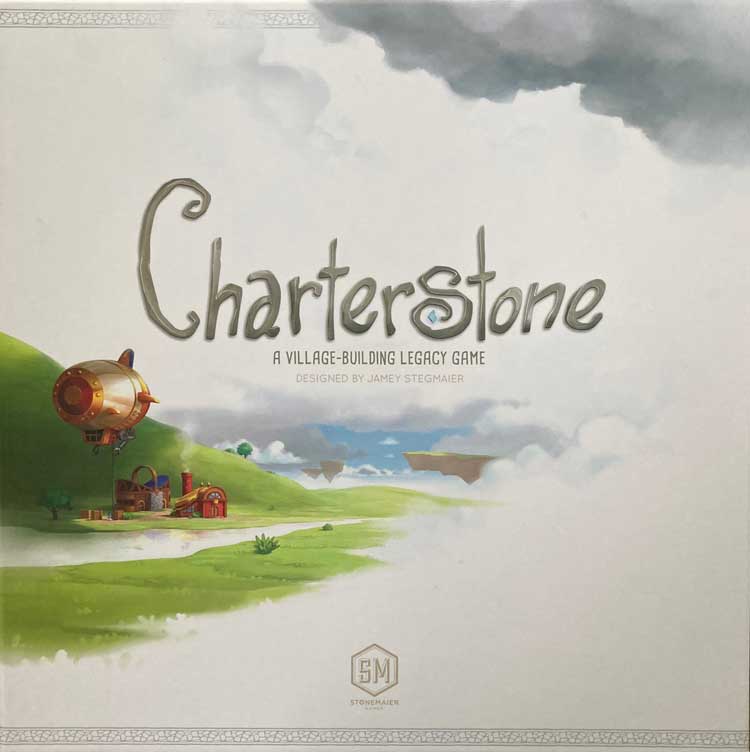Charterstone is a village-building legacy game published by Stonemaier Games. The premise of the game is to build a new village, with each player building their own charter. This is a legacy game played over 12 rounds. During each round, the board, tokens and other aspects of the game will change. At the end of 12 rounds, the player with the most victory points is declared the winner. Throughout the campaign, there are several ways to earn victory points.
This post is broken into the following 3 sections, feel free to jump directly to one:
- General summary - consisting of information about overall enjoyment, theme, replayability, and upgrades
- Complexity - consisting of information about the rulebook, setup, player turns, and overall learning curve
- Player turns - consisting of game type, game flow, rule you are likely to miss, and favorite aspect
General Summary
Number of players we had: 4
Our play time (not including setup): 3.5 hours
Round played: Round 12, the last round of the campaign
Overall enjoyment

Overall our group enjoyed playing this game. The board and the graphics are cute and it would be a great game to play as a family because the subject matter is family friendly. Each player has their own color-coordinated box of player materials including influence tokens, workers, supplies and more. The rules are simple to follow, starting out very scarce, and compounding over time.
In general, the players in our group are big fans of legacy games. Changes in rules, additions of characters and abilities, and having some control over how the game progresses keeps the game interesting and ensures nobody gets too comfortable with the game play. Legacy games vary greatly based on how much and what kinds of things change. This game included lots of changes, temporary rules for each round, and unexpected twists that kept it interesting.
We liked that there were additional persona cards that could be acquired over different rounds, and once acquired, were available for all future rounds. Additionally, we liked that each persona card is unique. This meant that you never knew what kind of opportunity or skill another player, or you, would be able to acquire.
If we had to pick something that frustrated us, it would be that when we first started the game we honestly felt like there weren't enough rules to know what to do. However, once we set up the game and got started, it quickly began to make sense.
One other thing I want to mention is that the time of play can vary greatly as you move through the rounds. We played the first two rounds in about 1½ hours, but took over 3 to finish the last round. This was partially our fault as we played too cooperatively in earlier games. In later rounds, when we did not have crates to bust or buildings to add to charters, games lasted longer because these are two of the three actions that move the progress token closer to the end of the game. So, I recommend that you don't rush through the buildings and crates too quickly!
Theme

The board is very detailed with pleasing graphics and colors. There are six different areas, or charters, each of which can be controlled by a different player. Each area focuses on a different resource and is different from the others. There are also several places where you name areas and characters, add to your charter, gain new tools and items, and tons more, which is part of the fun of playing a legacy game.
Replayability

There are several reasons why you replay this game. First, the game campaign is set up to cover 12 rounds, beginning with shorter games and increasing in complexity and length over time. Second, when the campaign is finished, you can still continue to play the game! This is because there is a small set of rules that replace those rules that only applied to the campaign. The new rules allow players to continue playing the game now using their fully created charter.
Lastly, and this is something we had never seen before, the game board is double-sided, with both sides matching. A campaign only utilizes one side so when you have finished, you can flip the board over and start another campaign. All you need is to order the recharge pack because there are lots of cards, etc., that have been used along the way. The recharge pack is reasonably priced and is a great way to get more use out of the game and all the tokens it has.
Upgrades

I have to be honest, a friend was nice enough to purchase the upgraded tokens for Charterstone for me, so I have no idea what they cost - but the attention to detail on them is incredible. Each of the upgraded tokens has a truer color, weight, and fantastic durability. We have not had a single problem with these tokens and I can't imagine ever getting rid of them.


Complexity
Rulebook
The rulebook is anything but complex. When you first begin there are almost no rules, just enough to get you started with a persona, an area and some naming of charters and the village. In most rounds of the campaign additional rules are added, more complex personas are acquired, and additional elements enter the game. The nice thing about this approach is that the game gets more challenging slowly so you have plenty of time to learn the flow of the game.
Setup
Setup is also simple and can be accomplished in about 10-20 minutes, which includes running through player bonuses.

Turns
Each player has the same options on their turn - place one of their two workers on a building in their own charter, in another player's charter or an unmanned charter, or in the commons area. Once both workers have been deployed, you must recover them on your next turn. I was lucky enough to secure a persona that allowed me to retrieve my workers once I placed my last worker. This saved me TONS of turns retrieving workers so I won't say which section this persona was a part of, and let you discover it on your own.
While there are only so many options for turns, at times some players' turns can lag as they try to figure out how to accomplish all the things they want/need to do before the end of the game or other players use those items, thereby blocking them. There are a couple of places where tokens cover available spots, and once covered, those cannot be used again.
As you progress to later rounds, players get to utilize several personas, as well as friends and guests. The compounded abilities and bonuses can take time to work through. However, we did not really notice this until our last couple of rounds in the campaign.
One last cool thing about this game, when you finish a round, there are several steps you follow to prepare the game for the next round. One such step reveals the guidepost for the next game. The guidepost introduces a temporary rule for the next round as well as an objective. Players who meet the objective get to reveal the guidepost after the next round and make a decision that will impact the game from then on. This was something that always got us excited to play the next round.
Overall learning curve
The overall learning curve of this game is low and steady. The game is presented simply, changing and adding rules or making small adjustments over time after you are already comfortable with the moves and game flow. Also, there are often temporary rules that apply to only a single round of the campaign, via the guidepost cards. We found these fun, not only because they provided a small side task for players, but because they sometimes shake up the game in ways you cannot anticipate.
Player Turns
Play type
Charterstone is a symmetrical, worker placement game. While there are unique abilities associated with personas, each is helpful at different times throughout the campaign so players essentially end up with an equal chance. Additionally, at the end of each round the players who did not have the most victory points for that round get a small bonus to counteract the victory points the winning player gets for the end of campaign scoring.
Game flow
The flow of this game can be faster paced since everyone is working with similar options. However, it can also slow down in later rounds if you bust crates and build the buildings too quickly in earlier rounds. I highly recommend not getting too wrapped up in those two activities, which I was completely guilty of in our campaign because it was my favorite thing to do, but later regretted.
Busting crates and adding buildings to your charter are two ways you introduce new items to the game, which can include all sorts of new and fun rules, items, etc. They can also help players add items to their charter that are strategic, allow them to accomplish new tasks or are just fun. The new buildings introduced are related to their main charter area, but there are tons of different and creative buildings that we always enjoyed discovering.
Rule you are likely to forget
Here are the rules you are likely to forget while playing this game:
- When someone takes an action that would move the progress token, be sure you actually move the progress token! It is an easy rule to follow, it is just that we would get caught up in the game play and forget.
- At the end of any round when you are storing supplies for the next round, if you have the ability to keep more than one advancement card, remember that they are required to be different types of advancement cards. In other words, you cannot keep three friends or two items.
- When you play later rounds, be sure to collect and take advantage of all of your extra benefits and advantages with the cards you have that game.
Favorite aspect
One of our favorite things about this game is that in many ways the game play is cooperative, even though it is a competitive game. For example, barring any temporary rules a player can place a worker on any building, even if another player's worker is already on that location. Second, you can always play on the buildings that other players have built, not just your charter (again barring any overriding temporary rules).
The only disadvantage to playing where someone else's worker is located is that they then get to retrieve that worker for free. This means playing where another player has a worker helps that player's game in a small way. Still, it is nice to be able to play anywhere you want at any time.
My absolute favorite part of this game is busting the crates which causes the introduction of new cards, elements, personas, and many other things I won't discuss here because I don't want to spoil the fun we had when we discovered new elements.
Overall we had fun with this game but there are things we will do differently in our next campaign. For instance, we will definitely let the earlier games finish without trying to stretch them out, knowing that not accomplishing everything we want to will make the next rounds that much more fun. Since we just finished our first campaign, we are hanging on to this game, switching to some other games for a bit before flipping the board and starting again with our recharge pack!


